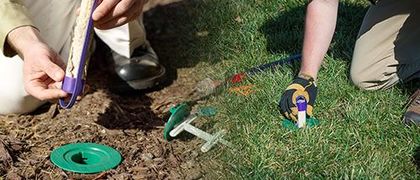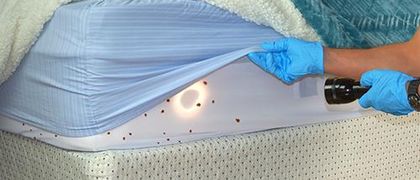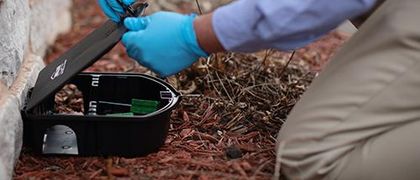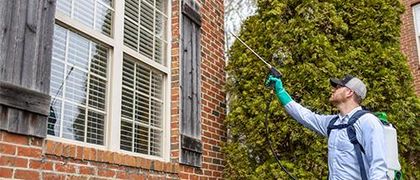What do fleas look like?
- Size: Up to 1/6 in.
- Color: Reddish brown
- Body structure: Flat body consisting of a head, thorax, abdomen, six legs, two eyes, and two short antennae. The mouth of a cat flea is made up of three mouthparts- two laciniae, an epipharynx, and the labium.
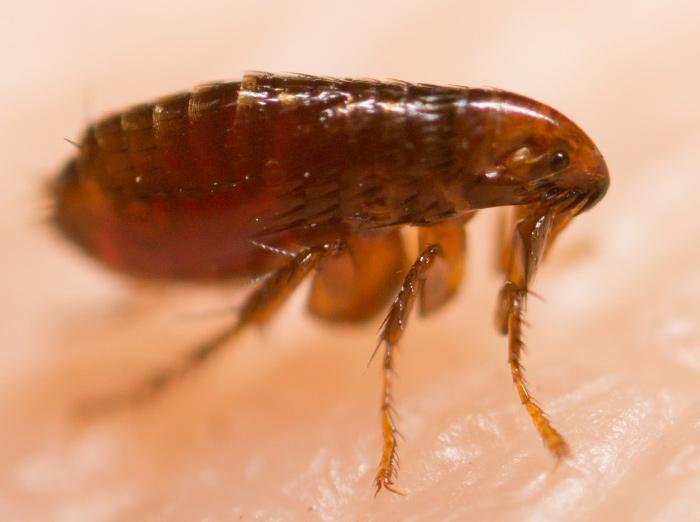
Characteristics of fleas
The flea’s life cycle has four stages: egg, larva, pupa, and adult. A couple of days after mating, the female adult lays 40-50 eggs on the body of her host. Because the eggs have nothing to adhere them to the host, they typically fall off and continue their development where they land. Within a week, the eggs hatch into larvae and, after another week, the larvae spin cocoons to become pupae. After another couple of weeks, the pupae develop into adults. Each stage of the cycle can move more slowly or quickly depending on environmental conditions. This flexible life cycle can take as little as two weeks and as long as two years for a flea to become an adult.
New adult fleas must have a blood meal within a week or they die. Generally, a flea usually lives between two and three months. However, fleas are capable of surviving a few months between meals if they don’t expend energy. A female flea can lay 2,000 eggs over the course of her short lifetime, quickly causing a serious infestation on their host and the areas it frequents.
When are fleas most active?
Where are fleas commonly found?
Fleas prefer low altitudes that are warm and humid, but will live anywhere they can find a suitable host. In the United States, fleas are most abundant in the Southeast and West Coast. They are least active in the dryer, colder states in the North, Midwest, and West.
Fleas are most commonly found on mammals, though they will also live on birds. In homes, fleas burrow into carpeting, furniture, pet beds, clothing, or any other location they can develop undisturbed.
What do fleas eat?
Fleas feed exclusively on blood. In fact, they require blood to survive so they seek out hosts that can provide sustenance. They are commonly found on dogs and cats, but will seek out other animals and also humans, as the opportunity arises.
Are fleas dangerous?
When fleas bite, they inject saliva which causes irritation and itchy red bumps. When hosts scratch, it aggravates the area even more and can result in a secondary skin infection and hair loss.
Fleas are known to transmit other harmful parasites and bacteria that can result in tapeworm, cat scratch disease, or flea allergy dermatitis. Fleas have also been known to cause anemia and carry bubonic plague. Left untreated, the conditions can become serious or even fatal.
Why do I have a flea problem?
Fleas are attracted to heat, carbon dioxide, and movement - that is how they find their hosts. Often fleas are introduced onto properties by rodents and passing wildlife or when domestic pets wander in areas prone to fleas. When they enter homes, it's usually on pets who go outdoors.
For properties that do not have pets, it's entirely possible that fleas entered under their own steam. You see, these parasitic pests have the ability to run quickly and jump up to 13 inches horizontally and 7 inches vertically.
Unfortunately, fleas can spread quickly but generally do not move directly from host to host. Instead, as they develop in the host’s environment, new fleas seek out targets. When a flea finds a host, it can remain there for a couple of months, feeding repeatedly for over two hours at a time. Female fleas, which tend to be larger than males, can ingest up to fifteen times their body weight in blood.
How do I get rid of fleas?
At Miller Pest & Termite, we offer effective pest control services that resolve flea problems for property owners in Iowa, Missouri, Kansas, and Nebraska. If you've found fleas in your home, reach out today to speak with our local pest pros regarding your flea problem.
How can I prevent a flea problem?
To prevent a flea infestation, you should start by talking to your vet about preventative treatments for your pets. You should also:
- Vacuum carpets and rugs often as well as cushions on chairs and couches
- Wash bedding regularly
- Clean pet bedding often
- Check your pets regularly for fleas
- Keep your lawn trimmed
- Avoid over-watering your grass
- Keep mice and other rodents off your property
- Do not feed wildlife


Get Help Now!






